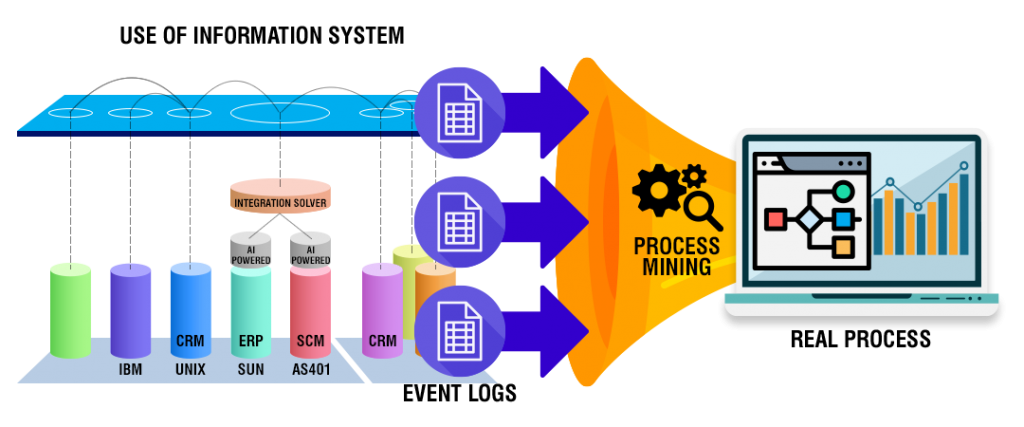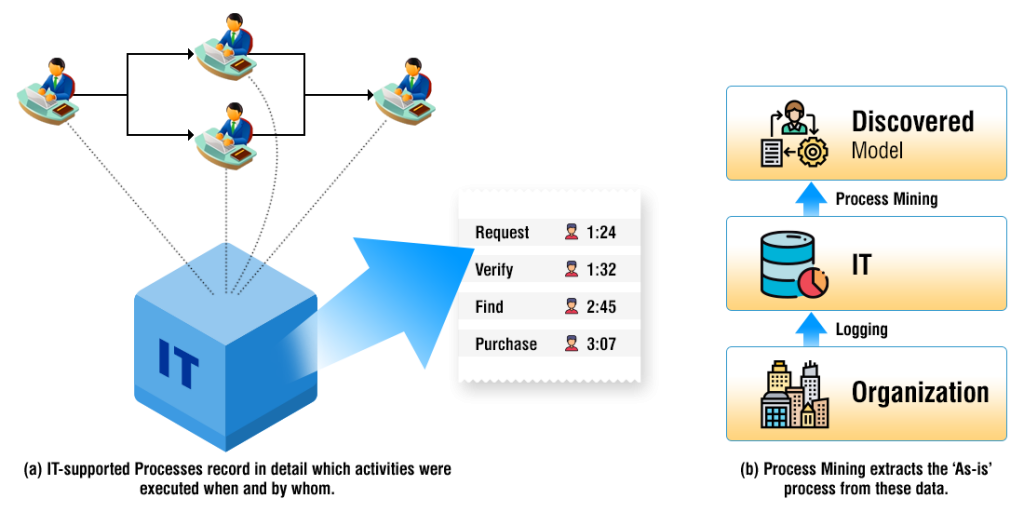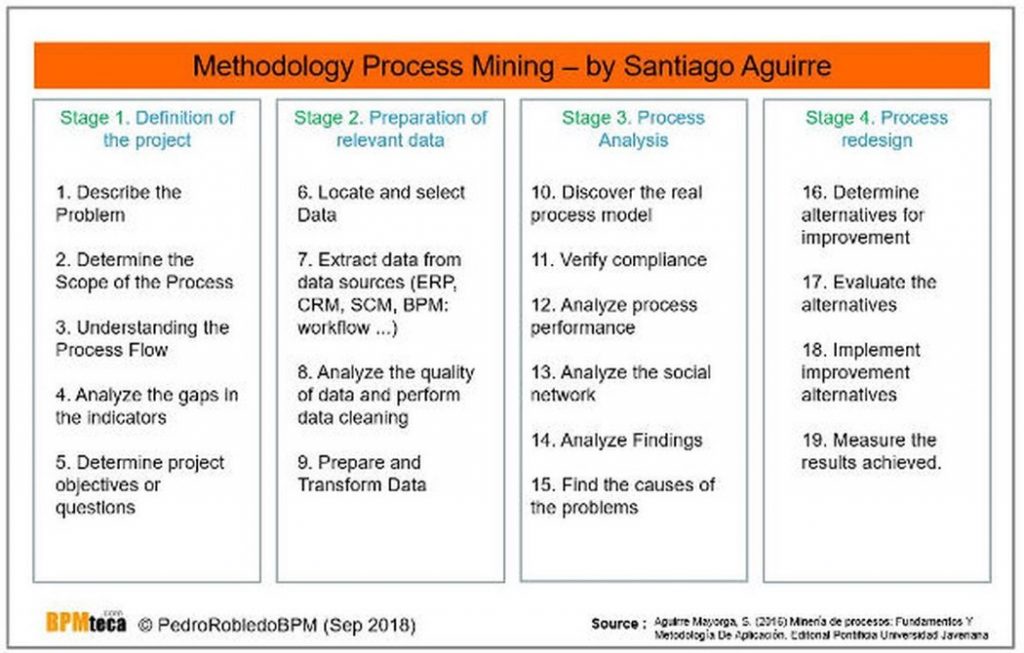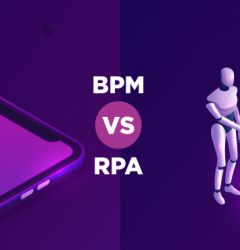
If there are two phrases we are hearing much too often today, they are “digital transformation” and “automation.”
Of course, this drastic change was overdue, but the pandemic catapulted it, eliminating any and all excuses for procrastination. If a business has to survive this uncertainty, it has to make digital transformation its key focus, the core of which is automation.
Here’s where the problem comes – all businesses know what to do. But how should they start?
Say hello to process-mining. But what is a process?
What is Process?
A process is a set of actions or steps that follow a specific sequence, beginning at a clearly defined starting point and concluding at an established endpoint. The main objective of a process is to ensure a structured and consistent workflow that enables the efficient completion of tasks. In a business context, each step within a process generates digital records, known as event log data, within transactional systems.Now let’s unwind the term Process Minning…
What is Process Mining?
Do you actually know what is a process mining ? And why is Forrester driving this change?

Whereas, Process-mining is a set of approaches that discovers real processes through event logs, monitors them, and works towards improving them. It is an analytical approach through which knowledge is extracted from the organization’s systems.
Through this process, organizations can detect errors and bottlenecks based on the facts instead of relying on conjectures. Overall, it covers the following:
- Checking the conformance of business processes
- Automated business process discovery
- Analyzing performance
The global process mining software market is expected to grow from USD 2.46 billion in 2024 to USD 14.42 billion by 2032, at a CAGR of 44.3%.
Are Process Mining and Data Mining the same?
Data mining has been a fad phrase for quite a while now. So, it is easy to confuse process-mining and data mining. In fact, many organizations fail to understand the difference. This is mainly because they are both a part of business intelligence and have quite a few similarities.
The differences, however, are significant.
- Data mining is a process of finding relationships in data sets to gain insights and improve accordingly. Big data is analyzed, and connections are established. This, in turn, helps unearth information that can be used in various ways. This technique is very popular in research.
- Process mining, as aforementioned, is all about analysis. It analyses the data in a system and finds ways to improve processes.
Also read: Business Process Management – The What, Why, and How
What are the Types of Process Mining?
There are 4 types of process mining, and we shall explore them in detail now:
1. Discovery

In this type, event logs come to the forefront. There’s no prior information, however. A process model is established based on the event logs and algorithms.
2. Conformance
Here, real processes and predefined processes are compared to identify similarities and differences. This helps find out deviations and fix them accordingly.
3. Enhancement
The data of real processes are considered to improve process models. Enhancement process-mining aims to improve existing processes by identifying bottlenecks, inefficiencies, or areas for optimization. It analyzes event logs to uncover opportunities for process improvement.
4. Extension
Extension process mining involves enriching existing process models with additional information, such as performance metrics, resource data, or cost information. It helps gain a more comprehensive understanding of the process and its associated factors.
Also Read: The Role of Process Standardization in Modern Organizations
What are the Benefits of Process Mining?
When we already have BPM, which is helping organizations transform digitally, do we really need it? How does it benefit organizations? The answer will both surprise and please you.
The benefits of process mining are multifaceted, contributing to enhanced operational efficiency and informed decision-making. Here are the key advantages:
Visibility and Transparency
Gain a clear, visual representation of end-to-end processes, providing transparency into how activities are executed.
Identifying Bottlenecks
Pinpoint bottlenecks and inefficiencies in processes, allowing for targeted improvements to enhance overall efficiency.
Process Optimization
Streamline and optimize existing processes based on real data insights, ensuring maximum efficiency and resource utilization.
Root Cause Analysis
Investigate the root causes of deviations or issues, enabling organizations to address underlying problems for long-term improvement.
Compliance Assurance
Ensure adherence to regulatory standards by monitoring processes for compliance issues and deviations.
Enhanced Decision-Making
Make data-driven decisions with a comprehensive understanding of how processes are executed and where improvements can be made.
Continuous Monitoring
Continuously monitor process performance in real-time, allowing for proactive intervention and immediate correction of deviations.
Automation Opportunities
Identify processes suitable for automation, driving efficiency by automating routine and repetitive tasks.
Improved Customer Experience
Optimize customer-facing processes, leading to improved service delivery and enhanced customer satisfaction.
Resource Optimization
Optimize resource allocation by understanding how resources are utilized throughout various processes.
Predictive Analysis
Forecast future process behavior based on historical data, allowing organizations to proactively address potential issues.
Process mining’s benefits extend across industries, providing organizations with actionable insights to drive continuous improvement, reduce costs, and foster innovation.
What are the Steps Involved in Process Mining?
Process mining typically unfolds in five interconnected phases. While some sources may group them into two broad categories—analysis and optimization—each stage plays a vital role in delivering actionable insights. Here’s a clearer breakdown:
1. Define Objectives & Select Processes
Start by identifying the business process to analyze, keeping your organization’s strategic goals in mind. Are you aiming to reduce costs, speed up service delivery, or improve compliance? Clear objectives help determine which processes and systems to prioritize.
2. Data Extraction from Event Logs
Next, gather event log data from enterprise systems like ERP (e.g., SAP), CRM, HRM, or workflow tools. This data typically includes case IDs, timestamps, and activity names—all essential for reconstructing the process flow.
3. Process Discovery
Use process mining software to generate an “as-is” model of the process. This visual representation reveals the actual path of execution, including common variations and bottlenecks—often uncovering surprises that weren’t visible through traditional analysis.
4. Conformance Checking
Compare the discovered model against predefined rules or the “ideal” process to check for deviations. This step helps detect non-compliance, rework, and unauthorized process changes—critical for risk management and quality control.
5. Improvement & Automation
Based on the findings, optimize the process by eliminating inefficiencies or unnecessary steps. You can then identify parts of the workflow that are suitable for automation using platforms like Quixy, enhancing speed, accuracy, and scalability.
These two steps are further broken down into multiple stages.
Santiago Aguirre did a wonderful job of explaining the methodology of process-mining in detail.


Use Cases of Process Mining
Process mining is a powerful analytical approach that leverages event data to gain insights into business processes. Here are some common use cases:
Process Optimization
Identify bottlenecks, inefficiencies, and areas for improvement in existing processes to enhance overall efficiency.
Compliance and Auditing
Ensure adherence to regulatory standards by analyzing process data to identify compliance issues and deviations.
Root Cause Analysis
Investigate the root causes of process deviations or failures, enabling organizations to address underlying issues.
Performance Monitoring
Continuously monitor process performance, track key metrics, and receive real-time alerts for deviations.
Automation Opportunities
Identify processes that can benefit from automation, streamlining operations and reducing manual intervention.
Customer Journey Analysis
Understand and optimize customer interactions by mapping out the complete customer journey across various touchpoints.
Fraud Detection
Detect unusual patterns or anomalies in process data that may indicate fraudulent activities or security breaches.
Supply Chain Visibility
Gain insights into the end-to-end supply chain processes, ensuring transparency and identifying areas for improvement.
IT System Auditing
Audit IT system logs to ensure compliance, security, and efficient utilization of resources.
Predictive Analysis
Forecast future process behavior based on historical data, allowing organizations to address potential issues proactively.
Also Read: Workflow vs Process: What are the Key Differences?
These use cases demonstrate the versatility of process mining in improving operational efficiency, ensuring compliance, and driving informed decision-making across various business domains.
Industries that can Leverage Process Mining
How do you apply process mining to industries? We have a few examples to help you understand:
1. Manufacturing
One of the most crucial aspects of manufacturing is timely delivery. When a business has multiple factories, delivery cannot rely on one aspect. Many differences come into the picture. Process-mining will help understand the process in every single region, right down to costs, KPIs of the people involved, and the duration. This fact-based analysis will automatically help optimize the process.
Also Read : Mastering Multiple Series Reports: Visualizing Complex Data in 4 Steps
2. Services
Service companies offer higher efficiency and lower costs to their clients through operational excellence. Process mining finds process inefficiencies and helps optimize operations.
3. Retail
Retail business operations are very extensive. They involve logistics, order management, forecasting, supply chain, customer service, etc. Process-mining provides visibility to the entire life cycle and the processes involved in each step. It helps unearth bottlenecks through facts so that they are taken care of immediately.
4. Banking
Rules and regulations are the driving force in the financial sector. Event data helps with process visualization in each step. If there is non-conformance to any rule, process-mining will help find that out along with deviations to the said rule.
Process mining analyzes event logs from your existing systems to uncover the true nature of your business processes. It exposes bottlenecks, inefficiencies, and repetitive tasks that are ripe for automation. However, simply identifying these opportunities isn’t enough. You need a way to transform them into reality.
Maximizing Process Mining ROI with Quixy’s Automation
Quixy is a low-code, no-code automation platform that seamlessly integrates with process mining data. This powerful combination allows you to:
- Target the Right Tasks: Leverage process mining insights to pinpoint the most impactful processes for automation, focusing on repetitive, high-volume tasks that drain valuable resources.
- Build Automation in Minutes: Quixy’s drag-and-drop interface and pre-built modules empower both technical and non-technical users to build automated workflows quickly and efficiently. No extensive coding experience is required.
- Streamline Workflows Effortlessly: Automate manual tasks identified through process mining, freeing up your team to focus on higher-value activities. This leads to improved productivity and faster turnaround times.
The Benefits of This Dynamic Duo
- Increased Efficiency: By automating repetitive tasks, you streamline workflows and reduce human error, leading to significant efficiency gains.
- Reduced Costs: Automating manual processes can lead to cost savings through improved resource allocation and reduced rework.
- Improved Compliance: Quixy allows you to build automated workflows that enforce specific business rules and regulations, ensuring compliance with industry standards.
- Faster Time-to-Value: Quixy’s low-code approach allows for rapid automation development, enabling you to reap the benefits of process mining data sooner.
Unlocking the Full Potential
Quixy doesn’t just stop at automation. It offers additional features like:
- Data Integration: Seamlessly connect Quixy with your existing systems to ensure automated workflows have access to the data they need.
- Reporting & Analytics: Track the performance of your automations and gain valuable insights to further optimize your processes.
- Scalability: Quixy scales with your needs, allowing you to automate more complex processes as your business grows.
Conclusion
Process mining may be relatively new but it is here to stay and optimize business processes. The insights this approach provides through analytics are crucial for growth and efficiency. Begin your journey towards streamlined operations and tailored apps – all with the simplicity of our platform. Get started today to harness the potential of automation.
Frequently Asked Questions (FAQs)
Q. What is Process Mining and why is it important?
Process mining is a technique that analyzes data from event logs to understand and improve business processes. It’s important because it helps organizations uncover inefficiencies, bottlenecks, and areas for improvement in their processes, leading to better operational efficiency and cost reduction.
Q. How does Process Mining benefit businesses?
Process mining offers several benefits for businesses. It provides insights into how processes are actually executed, helps identify bottlenecks or compliance issues, enables data-driven decision-making, improves process performance, and enhances overall operational efficiency.
Q. How Does Process Mining Differ from Traditional Data Analysis?
Process mining focuses on uncovering and visualizing real processes, while traditional data analysis often examines summarized data without a process-oriented view. Process mining provides insights into the actual sequence of activities, deviations, and bottlenecks in processes.
Q. Is Process Mining Suitable for All Industries?
Yes, process mining is versatile and applicable across various industries, including healthcare, manufacturing, finance, and logistics. It’s beneficial wherever there are structured processes to analyze and optimize.
Q. What Are the Main Steps in a Typical Process Mining Project?
A typical process mining project involves data extraction, preprocessing, process discovery, conformance checking, and process improvement. These steps help organizations gain insights, identify inefficiencies, and enhance processes.
Q. What Tools and Software are Used for Process Mining?
Popular process mining tools include Celonis, UiPath Process Mining, and Disco. These tools offer functionalities for data extraction, analysis, and visualization to support process improvement initiatives. Additionally, you can explore Quixy’s Business Process Automation ROI Calculator here for evaluating the potential return on investment when implementing process automation alongside process mining.
Q. Can Process Mining Work with AI and RPA?
Yes, Process-Mining can be synergistically combined with Artificial Intelligence (AI) and Robotic Process Automation (RPA) to optimize and automate business processes effectively. It enables data-driven insights and intelligent decision-making, streamlining operations and enhancing efficiency.

















I wouldn’t say process mining is new. Frederick Winslow Taylor and Frank and Lillian Gilbreth were pioneering this field way back in the early 1900s. Their tools were pencil, papers and stopwatches and their name for it was different, “time studies” and “scientific management”. But their methodology was very sound, rigorous and methodical. Their productivity increases were astounding. Henry Ford built his company and Jim Casey built UPS into behemoths by obsessively studying their processes and continually improving them. UPS’s term for it was “constructive dissatisfaction”. Deming and the Japanese almost made it a religion in the 50s and 60s. The Deming Cycle of Plan, Do, Study, Act became Kaizen. So its been around a long time. What is new are computer tools to help with this, at least ones that are generally available. But good article overall.